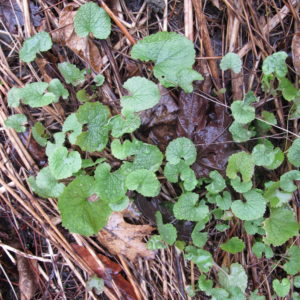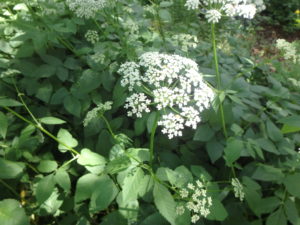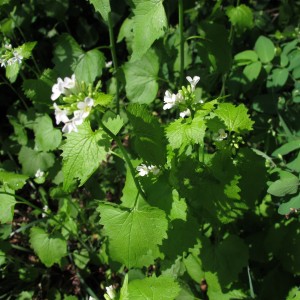Weeds to Worry About, and What to Do About Them
There are weeds to worry about. There is even one that I fear. But most weeds are just a nuisance and can be managed relatively easily. Dandelions, for example, are bright and cheerful. If they were named daffodil instead of dandelion, we would pay good money to have them in our lawn, returning each year and re-blooming after being mowed.
Yes, dandelions spread seeds willy-nilly on the wind. But if you pull them from your vegetable plot or flower beds when they are young, and after a good rain, you can keep them under control.
Let’s start with the worst weed: garlic mustard (Alliaria petiolata). I fear its arrival in my garden. This weed is a biennial, flowering in its second year and then dying. It is relatively easy to pull. So why worry? This plant exudes a chemical that kills the beneficial fungi that coat the roots of our maples, oaks and other hardwoods. Our trees depend on these mycorrhizal fungi to get minerals from the soil. Without the fungi they decline, and eventually die. This is not a quick death, but our forests are in danger if this invasive weed is allowed to spread. Garlic mustard also inhibits the seeds of many native wildflowers from germinating. I don’t have it, but fear it.
So what can you do? Learn to identify it, and then work hard at pulling it. In the first year it produces a low rosette of rounded leaves with scalloped edges an an indentation at the stem. The second year it sends up 18- to 36-inch flower spikes with pointy, heart-shaped leaves with jagged edges. The small white flowers have 4 petals and bloom in clusters about an inch or more in diameter. One plant can produce about 4,000 seeds. And although about 70% of the seeds will germinate the next year, some will remain viable in the soil for up to 10 years.
Pulling garlic mustard is easy – and satisfying. Do it now, before the flowers produce seeds. I find a CobraHead weeder is good for loosening the soil and helping me get the roots. But you will have to keep on doing this every year for 7 to 10 years. That’s why the weeds so often win the battle with us – we give up. And do not throw the plants into your compost! Bag and send to the landfill or incinerator.
Another nasty weed is called goutweed (Aegopodium podagraria). There are 2 forms: an all green variety and a green and white variety often called ‘Snow on the Mountain’, which is sometimes sold by garden centers (though it should not be). The green and white one is possible to control, but the all green one is almost impossible to eradicate. I got goutweed when a friend gave me some iris with roots of it mixed in. The long white roots are insidious –they break easily and a scrap will generate a new plant.
Again, know the plant and recognize the roots. If you buy plants at plant sales, I recommend you bare-root the plants before planting. Look for thick white roots that are not from the plant you bought. Bare-root by removing all soil with a hose and carefully inspecting the roots. Do that in your driveway, not in the garden as scraps of root can start a disaster, so clean up the scraps carefully.
Goutweed grows 12 to 24 inches tall and sends up stems with compound leaves: At the tip of each stem are 3 leaflets; two pairs of leaflets grow below that. Soon it will send up white flowers a bit like Queen Anne’s Lace. The roots spread fast and far. You can try to smother it with black plastic and mulch, but in my experience it just runs out from under the plastic before long.
Horsetail or Equisetum is a beautiful weed: very fine leaves arranged in whorls around a central stem. It has been growing for about 100 million years – perhaps it was fodder for dinosaurs. Instead of seeds, it produces spores. It can be quite persistent and difficult to eradicate.
Digging it and removing horsetail roots helps, but changing the soil type can be a big help. It tends to grow in compacted acidic clay soil. But according to one farmer I discussed it with, adding compost and limestone will make it less of a problem and other plants will compete with it better.
There are good weeds, too. Plantain (Plantago major) may use its broad leaves to smother grass in the lawn, but if you are stung by a bee you can reduce the pain by rubbing a leaf on the sting. It has been used as a medicinal for hundreds of years for a variety of ailments.
Chickweed (Stellaria media) blooms early when lady bugs need food before aphids appear. They survive on the pollen. It is shallow-rooted and easy to pull up.
Purslane (Portulaca oleracea) is a fleshy-leafed weed that prefers sandy fertile soil but will grow most anywhere. Like some other weeds, the flowers can produce seeds in the compost pile – or in a pathway after being yanked out. It’s virtue? It is edible. It can be used in salads, sautéed, or boiled. Every part of the plant is edible.
The bottom line? You can mow the weeds to reduce their vigor and their ability to produce seeds. You can smother them with a barrier and mulch. Or you can do it the old fashioned way: digging them out with a fork and a good weeding tool.
Henry lives and weeds in Cornish Flat, NH. Contact him at henry.homeyer@comcast.net. He is a UNH Extension Service Master Gardener and the author of 4 gardening books.
Garlic Mustard
As a garden writer I get a lot of email from people warning me about pending catastrophes: blights, bugs, invasive plants. Some are accurate, some are not. In 2012 we were told that a disease kills Impatiens (a lovely annual flower for shade) would make growing it impossible – ever again. But last year it did fine for many gardeners. Late blight on tomatoes is predicted every year, but my tomatoes have only been affected once. But I recently learned some disturbing news about an invasive weed, garlic mustard (Alliaria petiolata), that we should all pay attention to.
Invasive plants generally out-compete our native plants because they grow anywhere, often putting out leaves earlier in the spring than our natives, and holding them longer in the fall. Some, like the Norway maple, have roots that suck up water and nutrients far from the mother plant. Others, like barberry or honeysuckle, shade out natives in the understory of the forest. But garlic mustard, a seemingly innocuous little weed with a root system that is not hard to pull, goes one step beyond the others: it produces a toxin that kills necessary root-coating fungi on our maples, oaks and beeches. Where it grows, some of our favorite trees are in danger.
You may know that mycorrhizal fungi are beneficial fungi that coat the fine root hairs of many trees and perennial plants. They get sugars from the green plants and, as payback, share minerals that the green plants need but can’t extract from the minerals in their natural state. The mycorrhizal fungi produce acids that dissolve minerals in the soil and make them into a form that is readily taken up by the green plants. It’s a perfect symbiotic relationship: you scratch my back, I’ll scratch yours.
Here’s the bad news: Garlic mustard kills mycorrhizal fungi by producing chemicals and releasing them into the soil. Maples, oaks and white ash are all trees that depend on mycorrhizal fungi to succeed. Not only that, garlic mustard inhibits the germination of seeds of many species of native plants, including many spring wildflowers. And it has no natural predators here in the United States where it has invaded from Europe. In Europe it has at least 69 insect predators. Garlic mustard produces chemicals that make it uninteresting as food to herbivores like deer, as well as to insect predators.
So what can we do? First, understand its life cycle and learn to identify it. Garlic mustard is a biennial, meaning that it has a 2-year life cycle. In the first year it produces a low rosette of rounded leaves. The second year it sends up 18- to 36-inch flower spikes with pointy, heart-shaped leaves with jagged edges. The small white flowers have 4 petals and bloom in clusters about an inch or more in diameter. One plant can produce about 4,000 seeds. And although about 70% of the seeds will germinate the next year, some will remain viable in the soil for up to 10 years. A Web site full of good information is http://www.invasivespeciesinfo.gov/plants/garlicmustard.shtml.
Garlic mustard leaves when crushed smell a bit like garlic. Not as strong, but it has a distinct odor. The Europeans that brought it here in the 1860’s often grew it as an herb or a garlic substitute, and I have tasted pesto made from the leaves. But since it produces cyanide at a level much higher than other plants, I choose not to consume it. I figure that if the deer won’t eat it, I won’t either.
Here’s the good news: pulling up garlic mustard is easy. It has a white tap root that comes right out if you give it a tug. It is not like many pest weeds – it doesn’t spread by roots that easily break off and start new plants. Goutweed, Japanese knotweed and witch grass all spread by root, but garlic mustard does not. After pulling it, place garlic mustard in the household trash, not the compost pile. Or if you must, seal it in black plastic bags and let it rot in the sun until full decomposed.
How can you help to prevent its spread? Pull it if you see it. Watch for first year plants – it sometimes arrives in hay used for erosion control – it will grow in full sun or full shade. A good close mowing of plants will help, though one report I read said that garlic mustard cut at 10 cm (roughly 4 inches) would survive 29% of the time.
Garlic mustard is blooming right now! So go look for it. Organize a neighborhood group for a “pulling party”. It behooves us all to look out for it, and to do our best to reduce its numbers and prevent its spread.
Henry Homeyer can be reached at henry.homeyer@comcast.net. He is the author of 4 gardening books and a children’s chapter book about a boy and a cougar. His website is www.Gardening-guy.com.







